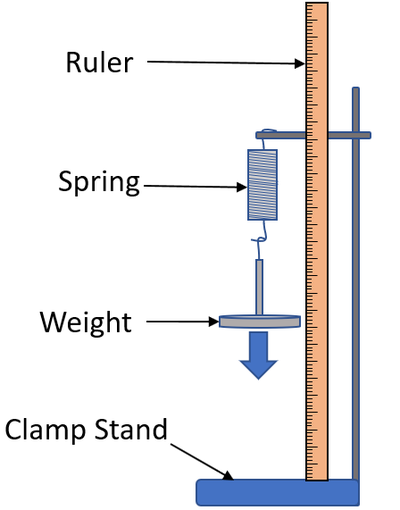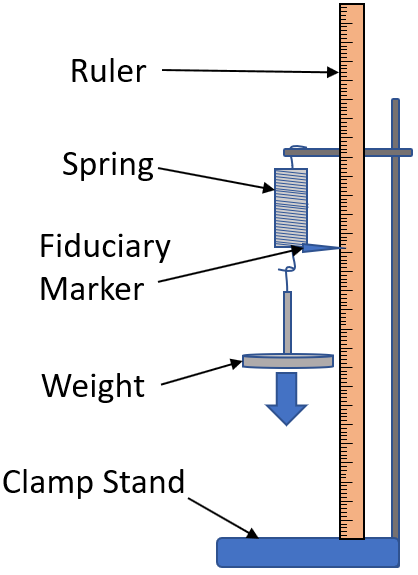Difference between revisions of "GCSE Physics Required Practical: Investigating Hooke's Law"
(Created page with "==Key Stage 4== ===Meaning=== Investigate the relationship between the extension of a spring and the force applied to that spring. ===...") |
(→Method) |
||
| Line 12: | Line 12: | ||
{| class="wikitable" | {| class="wikitable" | ||
|- | |- | ||
| − | |[[File:RequiredPracticalHookesLaw1.png|center| | + | |[[File:RequiredPracticalHookesLaw1.png|center|400px]] |
| style="height:20px; width:200px; text-align:center;" |A [[diagram]] of the [[apparatus]] used to investigate the effect of a [[force]] on the [[extension]] of a [[Coil Spring|spring]]. | | style="height:20px; width:200px; text-align:center;" |A [[diagram]] of the [[apparatus]] used to investigate the effect of a [[force]] on the [[extension]] of a [[Coil Spring|spring]]. | ||
|} | |} | ||
| Line 23: | Line 23: | ||
#Repeat steps 2-4 up to around 6N. | #Repeat steps 2-4 up to around 6N. | ||
#Plot a [[graph]] with the [[force]] of [[weight]] on the [[y-axis]] and the [[extension]] on the [[x-axis]]. The [[gradient]] of this [[graph]] will be the [[Spring Constant|spring constant]] of the [[Coil Spring|coil spring]]. | #Plot a [[graph]] with the [[force]] of [[weight]] on the [[y-axis]] and the [[extension]] on the [[x-axis]]. The [[gradient]] of this [[graph]] will be the [[Spring Constant|spring constant]] of the [[Coil Spring|coil spring]]. | ||
| + | |||
====Improving [[Accuracy]]==== | ====Improving [[Accuracy]]==== | ||
: Calculate the [[weight]] added by [[measure|measuring]] its [[mass]] each time and using the equation <math>W=mg</math> with <math>g=9.8</math>. This will give a more [[accuracy|accurate]] knowledge of the [[weight]] rather than relying on the number printed on the [[weight]]s. | : Calculate the [[weight]] added by [[measure|measuring]] its [[mass]] each time and using the equation <math>W=mg</math> with <math>g=9.8</math>. This will give a more [[accuracy|accurate]] knowledge of the [[weight]] rather than relying on the number printed on the [[weight]]s. | ||
Revision as of 09:42, 19 March 2019
Contents
Key Stage 4
Meaning
Investigate the relationship between the extension of a spring and the force applied to that spring.
Experiment
Variables
- Independent Variable: The force applied to the spring.
- Dependent Variable: The extension of the spring.
- Control Variables: The spring being used.
Method
| A diagram of the apparatus used to investigate the effect of a force on the extension of a spring. |
- Set up the equipment as shown in the diagram.
- Measure the original length of the spring using a ruler.
- Attach a known weight (approximately 1N) to the spring.
- Measure the new length of the spring.
- Calculate the extension of the spring by subtracting the original length from the new length of the spring.
- Repeat steps 2-4 up to around 6N.
- Plot a graph with the force of weight on the y-axis and the extension on the x-axis. The gradient of this graph will be the spring constant of the coil spring.
Improving Accuracy
- Calculate the weight added by measuring its mass each time and using the equation \(W=mg\) with \(g=9.8\). This will give a more accurate knowledge of the weight rather than relying on the number printed on the weights.
- Add a fiduciary marker to the bottom of the coil spring to prevent any error caused by not reading the ruler from eye level.
- Ensure the spring is not moving when taking measurements of it's length.
| A fiduciary marker can be added to improve accuracy and precision of the length measurements. |
Improving Precision
- Calculate the weight correct to two significant figures by measuring its mass to two significant figures each time and using the equation \(W=mg\) with \(g=9.8\). This will give a more precise knowledge of the weight rather than relying on the number printed on the weights which may be precise to only one significant figure.
- Add a fiduciary marker with a fine point to the bottom of the coil spring to give a precise reading of the length of the coil spring.

